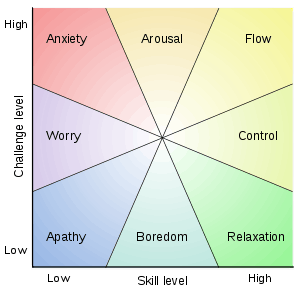Relaxation (psychology)

Cite error: There are <ref> tags on this page, but the references will not show without a {{reflist}} template (see the help page).
Relaxation in psychology, is the emotional state of a living being, of low tension, in which there is an absence of arousal that could come from sources such as anger, anxiety, or fear. Relaxation is a form of mild ecstasy coming from the frontal lobe of the brain in which the backward cortex sends signals to the frontal cortex via a mild sedative. Relaxation can be achieved through meditation, autogenics, and progressive muscle relaxation. Relaxation helps improve coping with stress. Stress is the leading cause of mental problems and physical problems[citation needed], therefore feeling relaxed is beneficial for a person's health. When we are stressed, the sympathetic nervous system is activated because we are in a fight-or-flight response mode; over time, this could have negative effects on a human body.
Meditation
Herbert Benson, a professor at the medical school at Harvard University, discovered the relaxation response which is a mechanism of the body that counters the Fight-or-flight response. The relaxation response reduces the body’s metabolism, heart and breathing rate, blood pressure, muscle tension, and calms brain activity. It increases the immune response, helps attention and decision making, and changes gene activities that are the opposite of those associated stress. The relaxation response is achieved through meditation. Benson's meditation technique involves these four steps:
- A quiet environment to help focus
- A mental device to help keep attention constant (a sound or word said repeatedly)
- A positive attitude to avoid getting upset over failed attempts
- A comfortable position
Autogenics
Autogenics was invented by Dr. Johannes Schulz in the 1920s. The process of autogenics is by relaxing muscles deeply, and by doing so, the mind follows through and relaxes as well. There as six parts to autogenics training:
- Heaviness in parts of the body (arms and legs feel heavy)
- Warmth in parts of the body (arms and legs feel warm)
- Heartbeat (heart is calm)
- Breathing (breathing is calm)
- Warmth in the abdominal area
- Forehead is cool
Progressive Muscle Relaxation
Progressive muscle relaxation helps relax your muscles by tensing certain parts of the body (such as the neck), and then releasing the tension in order to feel the muscles relaxing. This technique helps for people with anxiety because they are always tense throughout the day.
See also

References
Further reading
- Weiten, Wayne; McCann, Doug (2013). Psychology:Themes and Variations. Nelson Education. pp. 242 and 632.
- Raudebaugh, Candi. Inner Health Studio. p. About Relaxation. Retrieved April 1, 2013.
- Stress Relief Tools. 2012. Retrieved April 1, 2013.
- Grace, Susan. The Power of Autogenics. Retrieved April 1, 2013.
- How To Do Progressive Muscle Relaxation. Anxiety BC. Retrieved April 1, 2013.
